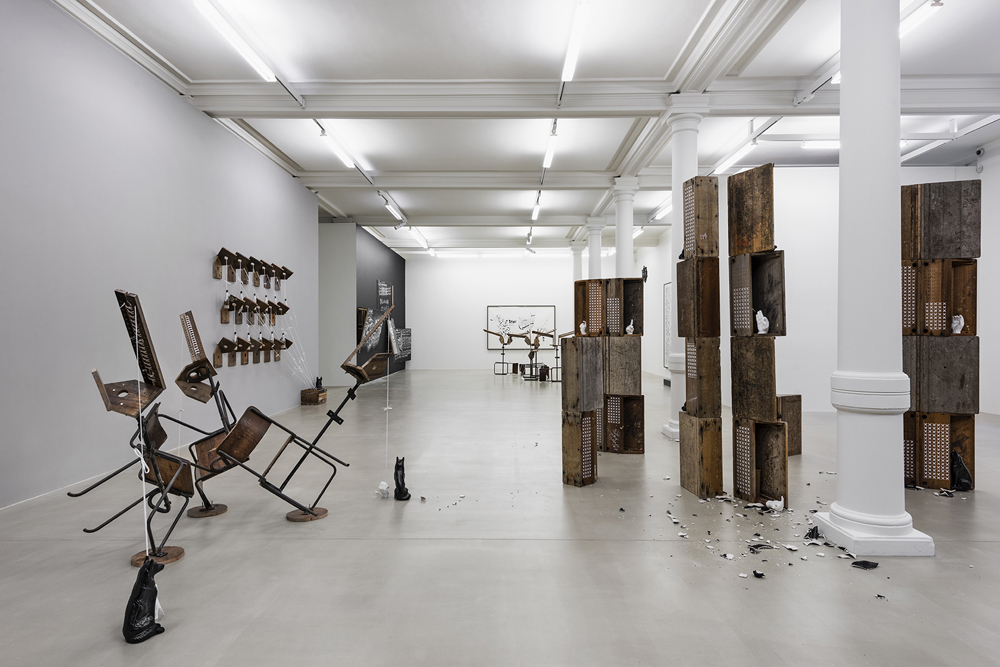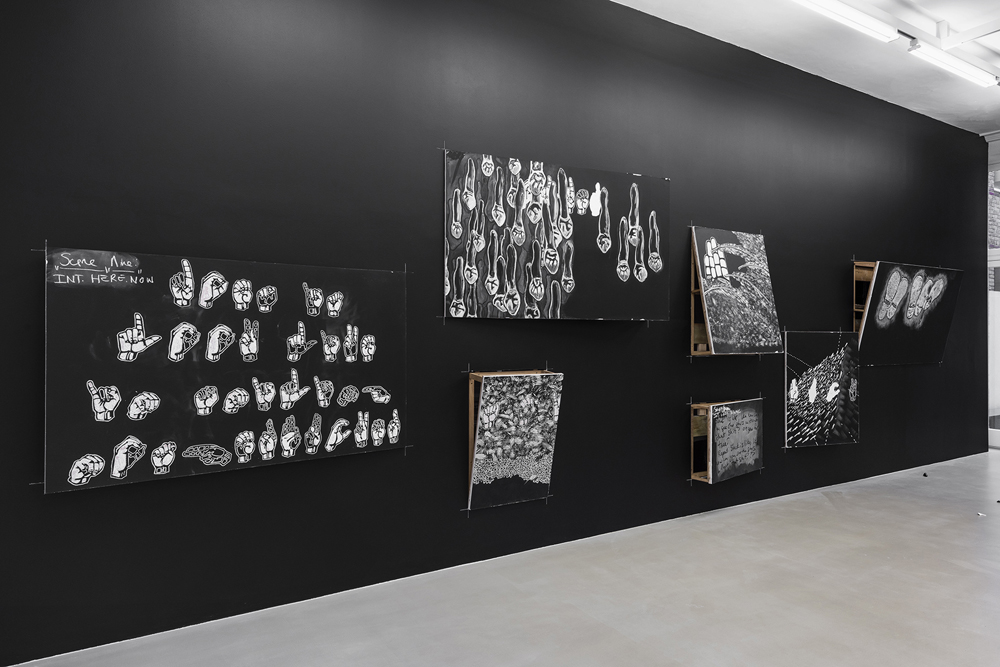COMPULSIVE STORYTELLING
ARTTHROB / 2018
The gallery floor is littered with porcelain shards and dust, the remnants of a ceramic dog smashed on the floor. There are more ceramic dogs, avoiding similar destruction by facing the corners of columns built out of repurposed school desks.
This is the scene created by When the walls fall, so do the writings on them, a work in Kemang Wa Lehulere’s new exhibition at the Marian Goodman Gallery in London. Wa Lehulere’s work often contains the residue of an action – evidence that the artist has been there, physically constructing the narrative of the exhibition – seen in the remains of the destroyed dog or the shavings from a carved chalkboard lying on the floor beneath it.
not even the departed stay grounded is not the artist’s first foray into exhibiting internationally. Wa Lehulere is an increasingly well-known name in the international art scene, recently participating in Performa 17 in New York. There he performed I cut my skin to liberate the splinter, a piece that is credited as the foundation for the work exhibited in this new body of work.
The exhibition contains many recognisable symbols for those familiar with Wa Lehulere’s work. The repurposed school chairs and desk appear often, a poignant reference to the Soweto student protests in 1976. Hands feature throughout the exhibition, either as casts or carved into chalkboards. They spell out letters and words in alphabetised sign language, while at the same time evoking the raised fist that has become synonymous with black empowerment movements, from Steve Biko to the Black Panthers. The casts are made from the hand of his aunt, who participated in the student uprising of 1976. Through these layers of meaning, the historical and political references in the works also express the deeply personal experiences of the artist and his family’s past and present.
Another familiar motif are the birdhouses, created from the salvaged school desks. Wa Lehulere suggests that these are inspired in part by Gladys Mgudlandlu, a South African artist from the 1960s. Birds featured prominently in many of Mgudlandlu’s paintings, asserting them as ‘symbols of freedom’. By featuring the birdhouse structure, Wa Lehulere’s works also come to symbolise the discrimination enacted during apartheid South Africa, when many communities were forcibly removed from their homes. The trauma still felt from this legacy is palpable in his birdhouse works.
The wooden circles that are left behind from creating the birdhouse entrances are used to construct Dead Eye, a large circular hanging structure surrounded by an array of objects, including glass bottles containing sand. The structure is lit from the inside to form shadows on the wall, enlivening the darkened room with light fragments that resemble stars in a night sky. The astrological focus of Dead Eye is a relatively new area of interest for Wa Lehulere, seen in both his Performa 17 performance and this work.
His references to astrology are nuanced, explained in the relevant press releases as coming from an interest in Mali’s Dogon people, who demonstrated unexpected knowledge of stars not visible to the human eye, and Cosmic Africa, a documentary about South African astrophysicist Thebe Medupe returning to his hometown to share his knowledge while learning from the indigenous myths about the stars. True to form, Wa Lehulere layers multiple ideas, references and narratives into Dead Eye, as he does with all his pieces.
Wa Lehulere’s background in storytelling, performance and theatre is ever-present in the exhibition. With many of the chalkboard works titled Scene, the gallery has become the stage. Sound, another performative element, features – the sound from Flaming doors, made up of a shaman-like circle of birdhouses and a school chair containing speakers, carries through the entire exhibition. The chanting vocals emanating from the speakers are from a Xhosa male initiation ceremony. This refers back to one of Wa Lehulere’s earliest works, Lefu La Ntate, a video of an upright cigarette burning down, accompanied by the sound of chanting taken from an initiation ritual song. The video was made in 2005, after he participated in the initiation ceremony himself.
he was not allowed to talk about apartheid history at home, because his aunt was involved in the Soweto school protests and it was too traumatic for the family to relive.
Wa Lehulere’s family history is complicated and, by his own admission, was not often talked about within his own family. He explains in an interview with curator Hans Ulrich Olbrist (for Art Basel 2012) that he was not allowed to talk about apartheid history at home, because his aunt was involved in the Soweto school protests and it was too traumatic for the family to relive. This gives some insight into the ideas which power his almost obsessive exploration of narrative, history and storytelling.
He seems to be compulsively telling a story that is unfinished, the same motifs and symbols appearing again and again. The work is both distinctly rooted in the history of South Africa and also incredibly personal; it is rich, layered and full of meaning. In not even the departed stay grounded, it’s easy to see why Kemang Wa Lehulere continues to garner well-deserved local and international acclaim.
By Siobhan Keam for Artthrob


